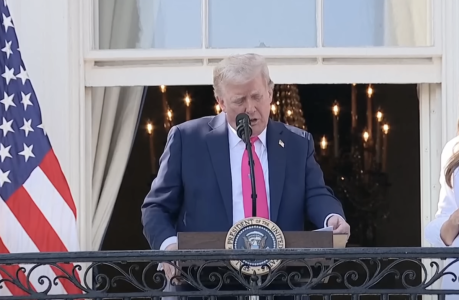What the "Big Beautiful Bill" could mean for your energy bills—and the environment
By
Veronica E.
- Replies 0
If you’ve been keeping an eye on rising utility bills or the direction of US energy policy, there’s a new law you may want to understand.
The recently signed One Big Beautiful Bill Act is bringing significant changes to how energy is produced, supported, and taxed in the US—and it could lead to higher household costs and slower progress on clean energy.
Let’s break down what this nearly 900-page law could mean for your wallet, your health, and the country’s energy future.
Over the last several years, the US made major strides in clean energy adoption.
Thanks in large part to incentives under the 2022 Inflation Reduction Act, more than 90% of new electricity generation came from wind, solar, and battery storage.
These technologies not only reduced emissions but created jobs and provided consumers with cost-saving options like solar panels and electric vehicles (EVs).

But under the new law, many of those tax credits are being phased out much earlier than planned.
Projects involving wind and solar must now start construction by mid-2026 or be operational by the end of 2027 to qualify for federal incentives.
Additionally, stricter sourcing rules around Chinese-made components are expected to create supply issues, even for projects built mostly with domestic materials.
The timeline for phasing out credits for slower-developing technologies—like nuclear and geothermal—remains more flexible.
Still, analysts like those at BloombergNEF have warned that the overall impact could be substantial.
Jesse Jenkins of Princeton University estimates that the policy change will result in 820 fewer terawatt-hours of clean electricity by 2035—more than the total output from all US coal plants in 2023.
Homeowners and drivers hoping to save on energy or emissions will feel the changes, too.
The tax credit for electric vehicles is scheduled to end after September 30, 2025.
At the same time, the bill eliminates penalties for car manufacturers that fail to meet fuel efficiency targets, which may lead to less-efficient vehicles entering the market.
Credits for energy-efficient home improvements—like heat pumps, better windows, or solar panels—will also expire at the end of 2025.
The solar panel tax credit, in particular, is ending seven years ahead of schedule.
Funding to reduce diesel emissions and support clean energy development in underserved communities has also been rescinded.
While clean energy incentives are being scaled back, subsidies for fossil fuels and biofuels are expanding.
The bill directs billions toward extending tax credits for ethanol and biodiesel, despite ongoing discussion about their environmental benefits.
It also opens up more federal lands and waters for oil, gas, and coal extraction—and reduces the royalties companies pay when drilling on public lands.
A new credit was also introduced to support metallurgical coal, a type used in steelmaking and largely exported abroad.
Additionally, the bill increases incentives for using captured carbon dioxide to extract more oil and gas, which experts warn may prioritize production over environmental benefit.
As one lawmaker put it, the shift is intentional. “We’re constraining the hell out of wind and solar, which is good,” said Rep. Chip Roy of Texas, who has received backing from the oil and gas industry.
All of this may hit consumers directly.
According to Jenkins, the average US household could pay more than $280 extra per year on energy by 2035 than they would have under the previous policy.
That’s on top of the environmental toll: the rollback is projected to erase 470 million tons of emissions reductions, equal to a 7% increase.
The political backdrop helps explain the timing. With Republicans in control of the White House and Congress, changes to the Inflation Reduction Act were expected.
Still, many analysts were surprised by the scale of the reversals—especially since several clean energy projects affected by the cuts were located in Republican-leaning districts.
Policy shifts like these can feel overwhelming, but there are still ways to stay informed and make thoughtful decisions:
As energy policy continues to evolve, many Americans are weighing the trade-offs between short-term savings and long-term sustainability.
Whether you support or oppose the changes, it’s clear that they’ll have lasting effects on household costs, the environment, and the country’s energy direction.
Read next: This one fridge setting tweak could help cut your energy bill by $43 a year

Do you think this bill takes the country in the right direction? Have you made energy upgrades at home? We’d love to hear your thoughts in the comments.
The recently signed One Big Beautiful Bill Act is bringing significant changes to how energy is produced, supported, and taxed in the US—and it could lead to higher household costs and slower progress on clean energy.
Let’s break down what this nearly 900-page law could mean for your wallet, your health, and the country’s energy future.
A shift away from clean energy support
Over the last several years, the US made major strides in clean energy adoption.
Thanks in large part to incentives under the 2022 Inflation Reduction Act, more than 90% of new electricity generation came from wind, solar, and battery storage.
These technologies not only reduced emissions but created jobs and provided consumers with cost-saving options like solar panels and electric vehicles (EVs).

President Donald Trump signed the One Big Beautiful Bill Act into law on July 4, 2025, marking a major shift in US energy policy. Image Source: YouTube / WBIR Channel 10.
But under the new law, many of those tax credits are being phased out much earlier than planned.
Projects involving wind and solar must now start construction by mid-2026 or be operational by the end of 2027 to qualify for federal incentives.
Additionally, stricter sourcing rules around Chinese-made components are expected to create supply issues, even for projects built mostly with domestic materials.
The timeline for phasing out credits for slower-developing technologies—like nuclear and geothermal—remains more flexible.
Still, analysts like those at BloombergNEF have warned that the overall impact could be substantial.
Jesse Jenkins of Princeton University estimates that the policy change will result in 820 fewer terawatt-hours of clean electricity by 2035—more than the total output from all US coal plants in 2023.
Also read: Claim your $7,500 car credit before the September 30 deadline
Home upgrades and EVs could cost more
Homeowners and drivers hoping to save on energy or emissions will feel the changes, too.
The tax credit for electric vehicles is scheduled to end after September 30, 2025.
At the same time, the bill eliminates penalties for car manufacturers that fail to meet fuel efficiency targets, which may lead to less-efficient vehicles entering the market.
Credits for energy-efficient home improvements—like heat pumps, better windows, or solar panels—will also expire at the end of 2025.
The solar panel tax credit, in particular, is ending seven years ahead of schedule.
Funding to reduce diesel emissions and support clean energy development in underserved communities has also been rescinded.
Also read: What did President Trump leave out? The surprising Social Security plan missing from his Big, Beautiful Bill
Fossil fuel and biofuel industries gain support
While clean energy incentives are being scaled back, subsidies for fossil fuels and biofuels are expanding.
The bill directs billions toward extending tax credits for ethanol and biodiesel, despite ongoing discussion about their environmental benefits.
It also opens up more federal lands and waters for oil, gas, and coal extraction—and reduces the royalties companies pay when drilling on public lands.
A new credit was also introduced to support metallurgical coal, a type used in steelmaking and largely exported abroad.
Additionally, the bill increases incentives for using captured carbon dioxide to extract more oil and gas, which experts warn may prioritize production over environmental benefit.
As one lawmaker put it, the shift is intentional. “We’re constraining the hell out of wind and solar, which is good,” said Rep. Chip Roy of Texas, who has received backing from the oil and gas industry.
Also read: Elon Musk criticizes Trump’s Immigration Bill, calling It a “disgusting abomination”
What it could cost you
All of this may hit consumers directly.
According to Jenkins, the average US household could pay more than $280 extra per year on energy by 2035 than they would have under the previous policy.
That’s on top of the environmental toll: the rollback is projected to erase 470 million tons of emissions reductions, equal to a 7% increase.
Also read: Cut $128.52 off your energy bill! Try this simple trick
Why now?
The political backdrop helps explain the timing. With Republicans in control of the White House and Congress, changes to the Inflation Reduction Act were expected.
Still, many analysts were surprised by the scale of the reversals—especially since several clean energy projects affected by the cuts were located in Republican-leaning districts.
Also read: How to score 9 hours of free electricity every day—See if your energy company is giving this away
What you can do
Policy shifts like these can feel overwhelming, but there are still ways to stay informed and make thoughtful decisions:
- Act soon if you’re eligible. If you’ve been thinking about upgrading your home’s energy systems or switching to an electric vehicle, check whether you still qualify for existing federal or local tax credits before they expire.
- Keep up with updates. Energy policy can change quickly. Staying tuned in to both national and local developments can help you make more cost-effective and informed choices.
- Use your voice. Whether you're concerned about rising costs, the environment, or long-term energy strategy, your representatives need to hear from you. Public feedback often shapes future revisions and policies.
- Focus on what you can control. Even as national incentives shift, utility companies and some states continue to offer programs supporting energy efficiency and clean technologies. It’s worth exploring your options.
As energy policy continues to evolve, many Americans are weighing the trade-offs between short-term savings and long-term sustainability.
Whether you support or oppose the changes, it’s clear that they’ll have lasting effects on household costs, the environment, and the country’s energy direction.
Read next: This one fridge setting tweak could help cut your energy bill by $43 a year
Key Takeaways
- The One Big Beautiful Bill Act, signed by President Trump in July 2025, reduces or ends key clean energy incentives while increasing subsidies for fossil fuels and biofuels.
- Tax credits for wind, solar, home efficiency, and EVs are being phased out earlier than planned, with some ending as soon as late 2025.
- The bill expands leasing of federal lands and waters for fossil fuel extraction, reduces company royalties, and introduces a new credit for metallurgical coal.
- Household energy bills are projected to rise by over $280 per year by 2035, with 470 million tons of emissions reductions lost.
Do you think this bill takes the country in the right direction? Have you made energy upgrades at home? We’d love to hear your thoughts in the comments.






